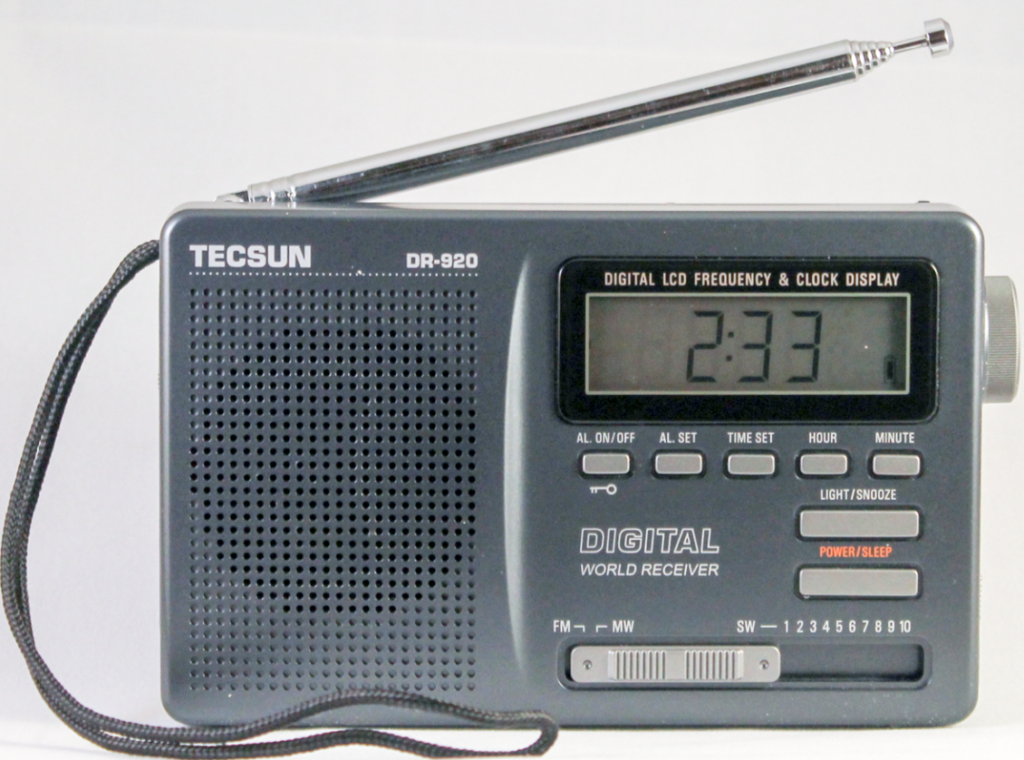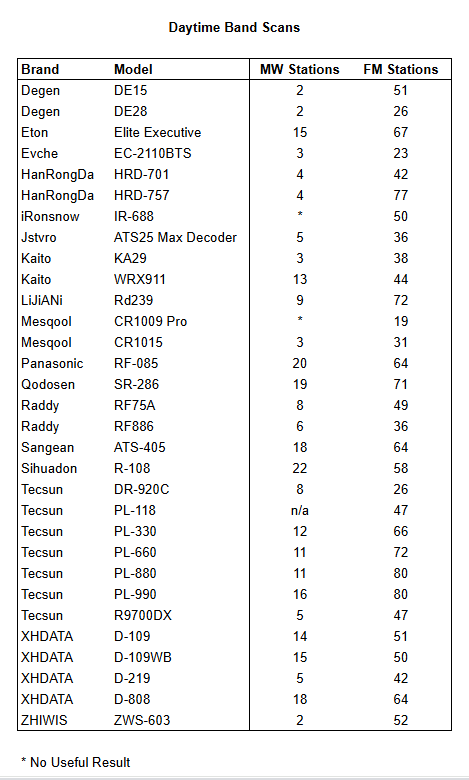I’ve had a DR-920 for years, but the internal string connecting the tuning knob to the variable capacitor went off track in a way I couldn’t repair, so I replaced it with a DR-920C. It cost $25.99 from Amazon, but I had enough “points” so there was nothing out of pocket.

The DR-920C is very much like its predecessor, the DR-920. The only differences I can find have to do with the power switch and the alarm. The DR-920 had a POWER/SLEEP button and a LIGHT/SNOOZE button (see photo below). On the side was a slide switch to set the alarm to wake to RADIO or BUZZER. The DR-920C has LIGHT and SLEEP buttons and an ON/OFF slide switch on the side, no wake to buzzer.
Time and alarm setting is a bit unusual in that you have to press as many as 3 buttons at the same time. To set the alarm, for example, you must hold down both the AL SET button and the TIME SET buttons while pressing the HOUR or MINUTE button to change the value. I should add that this radio has a 12-hour clock only.

The LIGHT button illuminates the display with a dim amber light that stays on for 10 seconds. The radio has a kickstand, a rotatable whip antenna 22 inches long, a 3v power input jack and an earphone jack. It’s a pretty basic radio.
The DR-920C is a rare breed these days, an analog radio with a digital display run by a frequency counter. The radio uses single-conversion superheterodyne technology, one in which the radio frequency signal is mixed with an internally generated signal, producing a 455 kHz “intermediate frequency,” which is then amplified and demodulated to create an audio signal that is amplified and sent to the speakers. The technology has been around a very long time; my first radio back in 1965 was a “superhet.” The inherent problem with this technology, and why today one would see it only on a cheaper shortwave radio, is images. A station is heard not only on its actual frequency, but if the signal is strong an image appears on its frequency +/- 455 kHz (more on that later).
One of the problems with the DR-920C is its limited coverage. It only covers 10 of the 14 international broadcast bands, and those only narrowly. WWV is of course not on an international broadcast band, but I heard it on the DR-920C on a frequency of 9090 kHz. That’s the real 10 kHz frequency minus 2 times 455. Likewise I received CHU Canada (7850) on 6940 kHz. I didn’t check in detail, but I got quite a few ham radio operators on SSB that I assume were images. Images are a problem I remember from the DR-920 too.
These are the published frequency ranges and the actual values from mine:
| Band | Published range | My radio range |
|---|---|---|
| MW | 525 – 1610 kHz | 507 – 1665 kHz |
| FM | 76 – 108 MHz | 75.2 – 109.5 MHz |
| SW1 (75m) | 3.90 – 4.00 MHz | 3.79 – 4.375 MHz |
| SW2 (60m) | 4.75 – 5.06 MHz | 4.64 – 5.265 MHz |
| SW3 (49m) | 5.95 – 6.20 MHz | 5.73 – 6.355 MHz |
| SW4 (41m) | 7.10 – 7.30 MHz | 6.90 – 7.90 MHz |
| SW5 (31m) | 9.50 – 9.90 MHz | 8.91 – 10.01 MHz |
| SW6 (25m) | 11.65 – 12.05 MHz | 11.43 – 12.42 MHz |
| SW7 (22m) | 13.60 – 13.80 MHz | 13.23 – 14.14 MHz |
| SW8 (19m) | 15.10 – 15.60 MHz | 14.985 – 15.75 MHz |
| SW9 (16m) | 17.55 – 17.90 MHz | 17.39 – 18.74 MHz |
| SW10 (13m) | 21.45 – 21.85 MHz | 21.22 – 22.42 MHz |
Note that my extended frequency range includes WWV on both 10 and 15 MHz. YRMV (your range may vary).
I scanned the MW band in the daytime, and there were 8 stations audible enough to make out words. That’s a good score for a budget portable/pocket radio, but well below medium ranged receivers. In the evening, as one would expect there were lots of MW stations. MW sensitivity is specified as 1.5 mV, which is 50% lower than usual. These scans are done in the same location around the same time of day (2 PM) but there is variability in atmospheric noise from day to day.
There were many FM stations that sounded strong, but when I got down to counting them, there were only 26, the lowest score for any radio I’ve tested. This doesn’t exactly say that the DR-920C is bad on FM, but rather that modern digital signal processing (DSP) receivers are just that much better on FM. With that said, I think this is a credible radio on FM, so long as you’re not stretching the limits of a station’s coverage. I should add that counting stations on this radio is a bit ticklish since they tend to bleed together.
Here are my current daytime MW/FM ratings:
Shortwave reception always depends on conditions. I ran an SW band scan around 01:30 UTC and it was pathetic. You can look at a test with the MLA-30+ antenna here:
But, two hours later, I got more and clearer stations with just the whip antenna.
I found the tuning knob very sensitive; that is, a small movement makes a big difference in frequency, making precise tuning difficult.The tuning knob has backlash, so you have to overshoot the desired frequency, and then let it roll back. I ended up rocking the knob back and forth a lot. The wide bandwidth with only 5 kHz resolution on the frequency display makes it easy to be 5 kHz off on the frequency reading. I found it helpful to close my eyes when trying to zero in on a station, leading to a more accurate frequency reading in the end.
The radio comes with an 8-page English user manual and a plush carrying bag. I’ll give the manual an A grade; it is literate, accurate, and informative. The text makes sense. I found two grammar errors and one wrong word (“bore” instead of “before”), but that’s far ahead of most of the competition.
I really miss the wake to buzzer feature of my old DR-920 because wake to radio requires you to set the station and volume before you turn it off, and the station might get changed in handling. The radio also drifts — changes frequency over time.
Modern digital signal processing (DSP) radios run rings around simple superhets like this, and at better prices. You could get a Retekess V115 for less money, and get a better radio with more features (MW will still suck). Still, there are people who prefer analog over DSP and this receiver bridges that gap with a digital frequency readout. Given the modest audio output level (150 mW) and minimal digital circuitry, I expect long battery life.
It’s not a bad bedtime radio.


DSP radios are not necessarily more sensitive than analog, they have problems with volume pumping, and miss faint stations when scanning. that’s why some people prefer analog.
this frequency counter display is less precise than digital but still better than the needle on an analog.